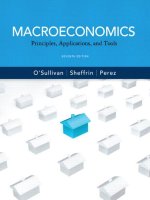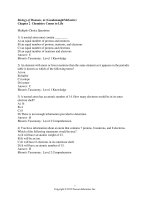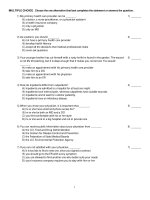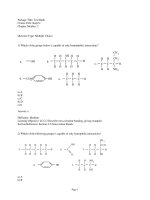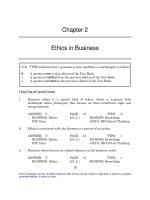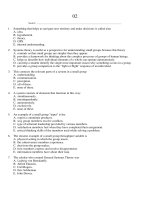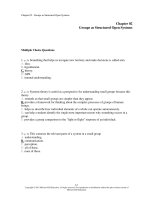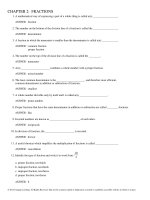Economics principles applications and tools 7th edition OSulliva test bank
Bạn đang xem bản rút gọn của tài liệu. Xem và tải ngay bản đầy đủ của tài liệu tại đây (320.12 KB, 55 trang )
Macroeconomics: Principles, Applications, & Tools, 7e (O'Sullivan) - Testbank 2
Chapter 2 The Key Principles of Economics
2.1 The Principle of Opportunity Cost
1) The opportunity cost of something is:
A) the cost of the labor used to produce it.
B) what you sacrifice to get it.
C) the price charged for it.
D) the search cost required to find it.
Answer: B
Diff: 1
Topic: The Principle of Opportunity Cost
Skill: Definition
2) The principle of opportunity cost:
A) is more relevant for firms than for individuals.
B) only refers to monetary payments.
C) is only relevant in economics.
D) is applicable to all decision-making.
Answer: D
Diff: 2
Topic: The Principle of Opportunity Cost
Skill: Conceptual
AACSB: Reflective Thinking
3) The principle that states that the cost of something is equal to what is sacrificed to get it is
known as the:
A) marginal principle.
B) principle of opportunity cost.
C) principle of diminishing returns.
D) reality principle.
Answer: B
Diff: 1
Topic: The Principle of Opportunity Cost
Skill: Definition
4) The saying that "There's no such thing as a free lunch" refers to the:
A) marginal principle.
B) spillover principle.
C) principle of opportunity cost.
D) reality principle.
Answer: C
Diff: 1
Topic: The Principle of Opportunity Cost
Skill: Conceptual
AACSB: Reflective Thinking
1
Copyright © 2012 Pearson Education, Inc.
5) Suppose that your tuition to attend college is $10,000 per year and you spend $4,000 per year
on room and board. If you were working full time instead of attending college, you could earn
$20,000 per year. What is your opportunity cost of attending college for one year?
A) $14,000
B) $24,000
C) $30,000
D) $34,000
Answer: C
Diff: 1
Topic: The Cost of College
Skill: Analytical
AACSB: Analytic Skills
6) Suppose that your tuition to attend college is $5,000 per year and you spend $5,000 per year
on room and board. If you were working full time, you could earn $22,000 per year. What is
your opportunity cost of attending college?
A) $13,000
B) $27,000
C) $30,000
D) $35,000
Answer: B
Diff: 1
Topic: The Cost of College
Skill: Analytical
AACSB: Analytic Skills
7) Mark quit his job as a salesman where he made $43,000 per year to start his own t-shirt
making business. His business expenses are $6,000 per year on rent, $12,000 per year on
supplies, and $4,000 per year on part-time help. As for his personal expenses, his apartment costs
him $4,800 per year and his personal bills are an extra $1,200 per year. What is Mark's
opportunity cost of running the business?
A) $65,000
B) $57,000
C) $71,000
D) $43,000
Answer: A
Diff: 2
Topic: The Principle of Opportunity Cost
Skill: Analytical
AACSB: Analytic Skills
2
Copyright © 2012 Pearson Education, Inc.
8) Mark quit his job as a salesman where he made $43,000 per year to start his own t-shirt
making business. His business expenses are $6,000 per year on rent, $12,000 per year on
supplies, and $4,000 per year on part-time help. As for his personal expenses, his apartment costs
him $4,800 per year and his personal bills are an extra $1,200 per year. Which of the following is
not part of the opportunity cost of running his business?
A) his apartment costs
B) his personal bills
C) his part-time labor costs
D) his apartment costs and his personal bills
Answer: D
Diff: 2
Topic: The Principle of Opportunity Cost
Skill: Conceptual
AACSB: Reflective Thinking
9) Suppose a ticket to a concert costs $39, and parking costs $5. Further, in order to watch the
concert, you must miss 2 hours of work where your hourly wage is $15 per hour. The total
opportunity cost of watching a concert is:
A) $74.
B) $44.
C) $39.
D) $30.
Answer: A
Diff: 2
Topic: The Principle of Opportunity Cost
Skill: Analytical
AACSB: Analytic Skills
10) An unemployed individual decides to spend the day fishing. The opportunity cost of fishing
is equal to:
A) the cost of bait and any other monetary expenses.
B) zero, because the person doesn't have a job.
C) the value of the individual's wages while he was working.
D) the cost of bait, any other monetary expenses, and the value of the best alternative use of the
individual's time.
Answer: D
Diff: 2
Topic: The Principle of Opportunity Cost
Skill: Analytical
AACSB: Analytic Skills
3
Copyright © 2012 Pearson Education, Inc.
11) The opportunity cost of going to college:
A) is zero if your parents pay your tuition.
B) is equal to the cost of tuition, room and board, and other expenses.
C) includes wages you lose by going to school instead of working.
D) is the same for all students at a particular school who pay full tuition.
Answer: C
Diff: 1
Topic: The Cost of College
Skill: Conceptual
AACSB: Reflective Thinking
12) Pat claims to save a great deal of money on groceries by traveling to various supermarkets to
make her purchases at their advertised sale prices. She might visit as many as five different
stores in one day in order to complete her weekly shopping. Her savings are not as great as she
may think they are if she does not consider the:
A) cost of the gasoline in driving from one store to another.
B) mileage she is putting on her car driving from one store to another.
C) value of the time she is spending doing the shopping as opposed to other things.
D) all of the above
Answer: D
Diff: 2
Topic: The Principle of Opportunity Cost
Skill: Analytical
AACSB: Reflective Thinking
13) Five years ago Tammy always took a big envelope full of coupons to the grocery store. Now
she has a child in pre-school, she rarely brings coupons. Which of the following is not a possible
explanation of this change in her behavior?
A) Fewer coupons appear in the newspapers than five years ago.
B) The opportunity cost of clipping coupons has risen above their monetary value.
C) Grocery prices have decreased.
D) The opportunity cost of grocery shopping has decreased.
Answer: D
Diff: 2
Topic: The Principle of Opportunity Cost
Skill: Analytical
AACSB: Analytic Skills
4
Copyright © 2012 Pearson Education, Inc.
14) Nancy and Melissa both have broken light fixtures in their living rooms. Nancy opts to hire
an electrician, while Melissa spends two hours replacing the fixture herself. Which of the
following is a possible explanation of this behavior?
A) Nancy dislikes electrical work more than Melissa.
B) Melissa is better at doing electrical work than Nancy.
C) The opportunity cost of Nancy's time is higher than her cost to hire an electrician.
D) All of the above are possible explanations of this behavior.
Answer: D
Diff: 2
Topic: The Principle of Opportunity Cost
Skill: Analytical
AACSB: Reflective Thinking
15) Suppose that you own a house. What is the opportunity cost of living in the house?
A) There is no opportunity cost because you own the house.
B) There is no opportunity cost unless you could set up a business in the house.
C) The opportunity cost is the rent you could have received from a tenant if you didn't live there.
D) The opportunity cost is the cost of your monthly mortgage payment plus bills.
Answer: C
Diff: 2
Topic: The Principle of Opportunity Cost
Skill: Conceptual
AACSB: Reflective Thinking
16) Steven lives in a big city where there is a shortage of parking. He has a parking spot in his
driveway where he parks his car. Which of the following statement is most correct?
A) Steven has a lower opportunity cost of owning a car than his neighbor, who must rent a
parking spot.
B) The opportunity cost of using the parking spot is zero, because Steven owns the house.
C) The opportunity cost of using the parking spot is the price he could charge someone else for
using the spot.
D) The opportunity cost depends on how much Steven's mortgage payment is.
Answer: C
Diff: 2
Topic: The Principle of Opportunity Cost
Skill: Analytical
AACSB: Reflective Thinking
5
Copyright © 2012 Pearson Education, Inc.
17) You have an hour between your economics and math classes. What is the opportunity cost of
that time if you use it to do math homework?
A) It depends on what you would do if you had no math homework.
B) It depends on how much you like math.
C) Zero, because an hour isn't long enough to go to a paying job.
D) Zero, because it doesn't cost any money to do your math homework.
Answer: A
Diff: 2
Topic: The Principle of Opportunity Cost
Skill: Conceptual
AACSB: Reflective Thinking
18) You rent a copy of a new action/adventure movie. The rental is for seven days and you watch
the movie on the first day. You tell a friend about the film and your friend asks to come over and
watch the movie with you before it is due back. What is your opportunity cost of watching the
movie a second time?
A) Zero, because it won't cost you any money to keep the movie for another day.
B) One half the rental cost, because you have already watched the movie one time.
C) The answer depends on how much you liked the movie in the first place.
D) The answer depends on what else you could do besides watching the movie.
Answer: D
Diff: 2
Topic: The Principle of Opportunity Cost
Skill: Conceptual
AACSB: Reflective Thinking
19) Jessica, aged three, decides to dress up like Sleeping Beauty for Halloween. What is her
opportunity cost of this decision?
A) the cost of the costume
B) the fact that she can't dress up like Barbie, her second choice
C) zero, because three-year-olds do not have opportunity costs
D) impossible to say, because Jessica does not understand what an opportunity cost is
Answer: B
Diff: 2
Topic: The Principle of Opportunity Cost
Skill: Conceptual
AACSB: Reflective Thinking
20) Spending money on a fixed budget is an example of:
A) the principle of opportunity cost.
B) how to survive with unlimited financial resources.
C) a bad thing to do because you run out of money.
D) living on the edge.
Answer: A
Diff: 1
Topic: The Principle of Opportunity Cost
Skill: Conceptual
AACSB: Reflective Thinking
6
Copyright © 2012 Pearson Education, Inc.
21) The saying that "There is no such thing as a free lunch" refers to:
A) the principle of reality in a modern world.
B) the price of fast food in today's economy.
C) the principle of diminishing returns.
D) the principle of opportunity cost.
Answer: D
Diff: 1
Topic: The Principle of Opportunity Cost
Skill: Conceptual
AACSB: Reflective Thinking
Figure 2.1
22) Referring to Figure 2.1, if you increase the production of farm goods, what other area is
affected?
A) the price of produce
B) the production of factory goods
C) how much people can purchase
D) the wages earned by farm workers
Answer: B
Diff: 1
Topic: Opportunity Cost and the Production Possibilities Curve, graph
Skill: Analytical
AACSB: Analytic Skills
7
Copyright © 2012 Pearson Education, Inc.
23) The production possibilities curve in Figure 2.1 illustrates the notion of:
A) increased factory goods production.
B) increased farm produce production.
C) diminishing resources.
D) opportunity cost.
Answer: D
Diff: 1
Topic: Opportunity Cost and the Production Possibilities Curve, graph
Skill: Analytical
AACSB: Analytic Skills
24) On the production possibilities curve in Figure 2.1 as agricultural production increases by
200 tons per year from 200 tons to 400 tons and then to 600 tons, the opportunity cost in terms of
tons of manufacturing goods:
A) rises.
B) falls.
C) is constant.
D) becomes negative.
Answer: A
Diff: 3
Topic: Opportunity Cost and the Production Possibilities Curve, graph
Skill: Analytical
AACSB: Analytic Skills
25) On the production possibilities curve in Figure 2.1 the opportunity costs of increasing
agricultural production from 200 tons to 400 tons is:
A) 600 tons of manufacturing products.
B) 500 tons of manufacturing products.
C) 200 tons of manufacturing products.
D) 100 tons of manufacturing products.
Answer: D
Diff: 2
Topic: Opportunity Cost and the Production Possibilities Curve, graph
Skill: Analytical
AACSB: Analytic Skills
26) On the production possibilities curve in Figure 2.1 the opportunity costs of increasing
agricultural production from 400 tons to 600 tons is:
A) 600 tons of manufacturing.
B) 500 tons of manufacturing.
C) 200 tons of manufacturing.
D) 100 tons of manufacturing.
Answer: C
Diff: 2
Topic: Opportunity Cost and the Production Possibilities Curve, graph
Skill: Analytical
AACSB: Analytic Skills
8
Copyright © 2012 Pearson Education, Inc.
27) On the production possibilities curve in Figure 2.1 the gain from decreasing manufacturing
production from 700 tons to 500 tons is:
A) 700 tons of agriculture.
B) 500 tons of agriculture.
C) 200 tons of agriculture.
D) 100 tons of agriculture.
Answer: C
Diff: 2
Topic: Opportunity Cost and the Production Possibilities Curve, graph
Skill: Analytical
AACSB: Analytic Skills
28) On the production possibilities curve in Figure 2.1 the gain from decreasing manufacturing
production from 500 tons to 300 tons is:
A) 700 tons of agriculture.
B) 500 tons of agriculture.
C) 200 tons of agriculture.
D) 100 tons of agriculture.
Answer: C
Diff: 2
Topic: Opportunity Cost and the Production Possibilities Curve, graph
Skill: Analytical
AACSB: Analytic Skills
29) If an economy is fully utilizing its resources, it can produce more of one product only if it:
A) doubles manufacturing of the product.
B) produces less of another product.
C) adds more people to the labor force.
D) reduces the prices of the most expensive products.
Answer: B
Diff: 1
Topic: Opportunity Cost & Production Possibilities Curve
Skill: Analytical
AACSB: Reflective Thinking
30) If you remove resources from factory production, the quantity of factory goods will:
A) increase.
B) decrease.
C) remain the same but their price will decrease.
D) be diverted to other production.
Answer: B
Diff: 1
Topic: Opportunity Cost & Production Possibilities Curve
Skill: Analytical
AACSB: Reflective Thinking
9
Copyright © 2012 Pearson Education, Inc.
Figure 2.2
31) Figure 2.2 presents a production possibilities curve for a country that can either produce
highways or provide people with medical care in a given year. The opportunity cost of the
second new highway built in a year is:
A) 30,000 people provided with medical care.
B) 40,000 people provided with medical care.
C) 50,000 people provided with medical care.
D) 500,000 people provided with medical care.
Answer: A
Diff: 1
Topic: Opportunity Cost & Production Possibilities Curve, graph
Skill: Analytical
AACSB: Analytic Skills
10
Copyright © 2012 Pearson Education, Inc.
32) Figure 2.2 presents a production possibilities curve for a country that can either produce
highways or provide people with medical care in a given year. The opportunity cost of the third
new highway built in a year is:
A) 10,000 people provided with medical care.
B) 50,000 people provided with medical care.
C) 90,000 people provided with medical care.
D) 450,000 people provided with medical care.
Answer: B
Diff: 1
Topic: Opportunity Cost & Production Possibilities Curve, graph
Skill: Analytical
AACSB: Analytic Skills
33) Figure 2.2 presents a production possibilities curve for a country that can either produce
highways or provide people with medical care in a given year. The opportunity cost of the fourth
new highway built in a year is:
A) less than the opportunity cost of the third new highway.
B) the same as the opportunity cost of the third new highway.
C) greater than the opportunity cost of the third new highway.
D) the sum of the opportunity costs of the first three highways built.
Answer: C
Diff: 1
Topic: Opportunity Cost & Production Possibilities Curve, graph
Skill: Analytical
AACSB: Analytic Skills
34) Figure 2.2 presents a production possibilities curve for a country that can either produce
highways or provide people with medical care in a given year. The opportunity cost of the fourth
new highway built in a year is:
A) less than the opportunity cost of the third new highway.
B) the same as the opportunity cost of the third new highway.
C) greater than the opportunity cost of the third new highway.
D) the sum of the opportunity costs of the first three highways built.
Answer: C
Diff: 1
Topic: Opportunity Cost & Production Possibilities Curve, graph
Skill: Analytical
AACSB: Analytic Skills
11
Copyright © 2012 Pearson Education, Inc.
35) Figure 2.2 presents a production possibilities curve for a country that can either produce
highways or provide people with medical care in a given year. The figure shows that the
production possibilities curve is:
A) bowed inward.
B) bowed outward.
C) a straight line.
D) bowed inward and then outward.
Answer: B
Diff: 1
Topic: Opportunity Cost & Production Possibilities Curve, graph
Skill: Definition
AACSB: Analytic Skills
36) Figure 2.2 presents a production possibilities curve for a country that can either produce
highways or provide people with medical care in a given year. The reason why the production
possibilities curve is shaped as it is (bowed outward) is because inputs for healthcare and
highways are:
A) used in precisely the same ratios.
B) substitutable, but not perfectly substitutable.
C) not substitutable at all.
D) perfectly substitutable.
Answer: B
Diff: 3
Topic: Opportunity Cost & Production Possibilities Curve, graph
Skill: Analytical
AACSB: Analytic Skills
37) Figure 2.2 presents a production possibilities curve for a country that can either produce
highways or provide people with medical care in a given year. The figure shows that as more
highways are built, the opportunity cost of building each additional highway is:
A) decreasing.
B) increasing.
C) constant.
D) decreasing and then increasing.
Answer: B
Diff: 2
Topic: Opportunity Cost & Production Possibilities Curve, graph
Skill: Analytical
AACSB: Analytic Skills
12
Copyright © 2012 Pearson Education, Inc.
38) Figure 2.2 presents a production possibilities curve for a country that can either produce
highways or provide people with medical care in a given year. The opportunity cost of the fourth
new highway built in a year is:
A) 50,000 people provided with medical care.
B) 70,000 people provided with medical care.
C) 30,000 people provided with medical care.
D) 90,000 people provided with medical care.
Answer: B
Diff: 2
Topic: Opportunity Cost & Production Possibilities Curve, graph
Skill: Analytical
AACSB: Analytic Skills
Table 2.1
39) A group of people has formed a house cleaning and yard maintenance business. The number
of houses or yards that they can clean or maintain in any given day is depicted in Table 2.1. The
opportunity cost of cleaning the first house in a day is:
A) 0 yards maintained.
B) 1 yard maintained.
C) 2 yards maintained.
D) 20 yards maintained.
Answer: B
Diff: 1
Topic: Opportunity Cost & Production Possibilities Curve
Skill: Analytical
AACSB: Analytic Skills
13
Copyright © 2012 Pearson Education, Inc.
40) A group of people has formed a house cleaning and yard maintenance business. The number
of houses or yards that they can clean or maintain in any given day is depicted in Table 2.1. The
opportunity cost of cleaning the second house in a day is:
A) 1 yard maintained.
B) 2 yards maintained.
C) 3 yards maintained.
D) 18 yards maintained.
Answer: B
Diff: 1
Topic: Opportunity Cost & Production Possibilities Curve
Skill: Analytical
AACSB: Analytic Skills
41) A group of people has formed a house cleaning and yard maintenance business. The number
of houses or yards that they can clean or maintain in any given day is depicted in Table 2.1. The
opportunity cost of cleaning the third house in a day is:
A) 1 yard maintained.
B) 2 yards maintained.
C) 3 yards maintained.
D) 15 yards maintained.
Answer: C
Diff: 1
Topic: Opportunity Cost & Production Possibilities Curve
Skill: Analytical
AACSB: Analytic Skills
42) A group of people has formed a house cleaning and yard maintenance business. The number
of houses or yards that they can clean or maintain in any given day is depicted in Table 2.1. As
the group cleans more houses, the opportunity cost of cleaning houses:
A) falls.
B) rises.
C) stays the same.
D) is the sum of the opportunity costs of cleaning all the houses prior to that one.
Answer: B
Diff: 1
Topic: Opportunity Cost & Production Possibilities Curve
Skill: Analytical
AACSB: Analytic Skills
14
Copyright © 2012 Pearson Education, Inc.
43) A group of people has formed a house cleaning and yard maintenance business. The number
of houses or yards that they can clean or maintain in any given day is depicted in Table 2.1. As
the group cleans more houses, the opportunity cost of doing yard work:
A) falls.
B) rises.
C) stays the same.
D) becomes equal to the opportunity cost of cleaning houses.
Answer: B
Diff: 2
Topic: Opportunity Cost & Production Possibilities Curve
Skill: Analytical
AACSB: Reflective Thinking
Figure 2.3
44) In Figure 2.3, the move from production possibility curve XV to production possibility curve
YZ could be caused by:
A) decreased unemployment.
B) more land, labor or capital.
C) a decline in technology.
D) all of the above.
Answer: B
Diff: 2
Topic: Opportunity Cost & Production Possibilities Curve, graph
Skill: Analytical
AACSB: Analytic Skills
15
Copyright © 2012 Pearson Education, Inc.
45) In Figure 2.3, point B:
A) implies unemployment of some resources.
B) is the optimum.
C) cannot be produced.
D) all of the above.
Answer: C
Diff: 2
Topic: Opportunity Cost & Production Possibilities Curve, graph
Skill: Analytical
AACSB: Analytic Skills
46) In Figure 2.3, point A:
A) implies unemployment of some resources.
B) is the optimum.
C) cannot be produced.
D) all of the above.
Answer: A
Diff: 2
Topic: Opportunity Cost & Production Possibilities Curve, graph
Skill: Analytical
AACSB: Analytic Skills
47) In Figure 2.3, an efficient production point on production possibility curve XV is
A) point A.
B) point B.
C) point C.
D) none of the above.
Answer: C
Diff: 2
Topic: Opportunity Cost & Production Possibilities Curve, graph
Skill: Analytical
AACSB: Analytic Skills
48) In Figure 2.3, an efficient production point on production possibility curve YZ is
A) point A.
B) point B.
C) point C.
D) none of the above.
Answer: D
Diff: 2
Topic: Opportunity Cost & Production Possibilities Curve, graph
Skill: Analytical
AACSB: Analytic Skills
16
Copyright © 2012 Pearson Education, Inc.
49) In Figure 2.3, the move from production possibility curve YZ to production possibility curve
XV, could be caused by:
A) increased unemployment.
B) more land, labor or capital.
C) a decline in technology.
D) all of the above.
Answer: C
Diff: 2
Topic: Opportunity Cost & Production Possibilities Curve, graph
Skill: Analytical
AACSB: Analytic Skills
Recall Application 1, "Don't Forget the Costs of Time and Invested Funds," to answer the
following questions.
50) According to the application,if this year Betty spends $100,000 of her own money on
materials, the interest rate is 5%, has living expenses of $20,000 and could have made $50,000 in
her former line of employment, then Betty's opportunity cost of operating the business this year
is:
A) $50,000.
B) $55,000.
C) $150,000.
D) $155,000.
Answer: B
Diff: 2
Topic: Application 1, Don't Forget the Costs of Time and Invested Funds
Skill: Analytical
AACSB: Analytic Skills
51) According to the application, if the interest rate rises, then the opportunity costs of running a
business:
A) rises.
B) falls.
C) is unchanged.
D) cannot be determined with the information given.
Answer: A
Diff: 2
Topic: Application 1, Don't Forget the Costs of Time and Invested Funds
Skill: Conceptual
AACSB: Reflective Thinking
17
Copyright © 2012 Pearson Education, Inc.
52) According to the application, if Betty's living expenses rises, then the opportunity costs of
running a business:
A) rises.
B) falls.
C) is unchanged.
D) cannot be determined with the information given.
Answer: C
Diff: 2
Topic: Application 1, Don't Forget the Costs of Time and Invested Funds
Skill: Conceptual
AACSB: Reflective Thinking
53) A principle is a self-evident truth that most people readily understand and accept.
Answer: TRUE
Diff: 1
Topic: The Key Principles of Economics
Skill: Definition
54) Opportunity cost is the difference between the benefit and cost of some action.
Answer: FALSE
Diff: 1
Topic: The Principle of Opportunity Cost
Skill: Definition
55) An increase in the benefit from undertaking an activity will result in an increase in the
opportunity cost of that activity.
Answer: FALSE
Diff: 1
Topic: The Principle of Opportunity Cost
Skill: Conceptual
AACSB: Reflective Thinking
56) An increase in the wages received by lawyers in general will result in an increase in the
opportunity cost of law school.
Answer: FALSE
Diff: 1
Topic: The Principle of Opportunity Cost
Skill: Conceptual
AACSB: Reflective Thinking
57) In order to go to college, James incurs an opportunity cost even though all he gave up was a
full time job as a clerk at Wally World.
Answer: TRUE
Diff: 1
Topic: The Cost of College
Skill: Conceptual
AACSB: Reflective Thinking
18
Copyright © 2012 Pearson Education, Inc.
58) The opportunity cost of going to a particular college is not the same for everyone.
Answer: TRUE
Diff: 2
Topic: The Cost of College
Skill: Analytical
AACSB: Reflective Thinking
59) The opportunity cost of getting a master's degree in engineering equals the tuition plus the
cost of books.
Answer: FALSE
Diff: 1
Topic: The Cost of College
Skill: Conceptual
AACSB: Reflective Thinking
60) The opportunity cost of something is what you sacrifice to get it.
Answer: TRUE
Diff: 1
Topic: The Principle of Opportunity Cost
Skill: Definition
61) Tradeoffs involve an exchange of one thing for another because resources are limited and
can be used in different ways.
Answer: TRUE
Diff: 1
Topic: The Principle of Opportunity Cost
Skill: Conceptual
AACSB: Reflective Thinking
62) The notion of opportunity cost allows the measurement of tradeoffs.
Answer: TRUE
Diff: 1
Topic: The Principle of Opportunity Cost
Skill: Conceptual
AACSB: Reflective Thinking
63) What is the opportunity cost of your college degree?
Answer: A quick answer would be to say that the cost is the tuition, room and board, and books
expenditures that are borne during the college years. But such a statement would be incorrect.
First, it understates one aspect of costs: one is giving up income while a student. But it also
overstates the costs in another dimension: people would eat and sleep somewhere regardless of
their attendance in college. So one should not consider room and board to be part of the cost of
college attendance.
Diff: 1
Topic: The Cost of College
Skill: Conceptual
AACSB: Reflective Thinking
19
Copyright © 2012 Pearson Education, Inc.
64) What do economists mean when they say that there is "no such thing as a free lunch"?
Answer: Everything has a cost, even when you do not pay money for it. Suppose that somebody
bought you lunch. The opportunity cost of that lunch is the lost opportunity to spend your time
otherwise.
Diff: 1
Topic: The Principle of Opportunity Cost
Skill: Conceptual
AACSB: Reflective Thinking
65) Suppose that you lend $1,000 to a friend who pays you back $1,100 the next year. Suppose
that prices that year rose by 8% and the real rate of return in the stock market was 4%. Your
friend says that he or she was being more than fair by giving you more than the rate of inflation
as a return. What do you think?
Answer: The opportunity cost of that money was not just the 8% inflation, but also the real rate
of return that would have been enjoyed had the money been put in the stock market. For you to
have been indifferent between loaning your money versus keeping it, your friend should have
reimbursed you by $1,120, or a 12% return. This is another example of considering all the costs,
both the loss in purchasing power of the money due to inflation and the implicit cost of the return
that could have been earned if the money was invested in the stock market.
Diff: 3
Topic: The Principle of Opportunity Cost
Skill: Analytical
AACSB: Analytic Skills
66) What is the opportunity cost of investing $10,000 of your own money in a business you wish
to start?
Answer: The opportunity cost of your $10,000 is the money you lose because you cannot invest
the money elsewhere.
Diff: 2
Topic: The Principle of Opportunity Cost
Skill: Analytical
AACSB: Reflective Thinking
67) By making acquisitions, resources are used that could have been used to ________.
Answer: acquire something else
Diff: 1
Topic: The Principle of Opportunity Cost
Skill: Conceptual
AACSB: Reflective Thinking
20
Copyright © 2012 Pearson Education, Inc.
2.2 The Marginal Principle
1) The additional cost resulting from a small increase in some activity is called the:
A) opportunity cost.
B) marginal benefit.
C) marginal cost.
D) diminishing returns of the activity.
Answer: C
Diff: 1
Topic: The Marginal Principle
Skill: Definition
2) When economists use the term "marginal," they usually refer to
A) small, incremental change.
B) large changes.
C) no changes.
D) average change.
Answer: A
Diff: 1
Topic: The Marginal Principle
Skill: Definition
3) The marginal principle states that "we should increase the level of an activity as long as:
A) its marginal benefit exceeds it marginal cost."
B) its marginal cost exceeds its marginal benefit."
C) its total benefit exceeds its total cost."
D) its total cost exceeds its total benefit."
Answer: A
Diff: 1
Topic: The Marginal Principle
Skill: Definition
4) If the government estimates that the marginal cost of building a bridge is $100 million, while
the marginal benefit is $150 million, the marginal principle dictates that the government should:
A) build the bridge.
B) never build the bridge.
C) wait until the marginal cost of building the bridge rises to above $150 million before building
the bridge.
D) wait until the marginal benefit of building the bridge drops to below $100 million before
building the bridge.
Answer: A
Diff: 1
Topic: The Marginal Principle
Skill: Conceptual
AACSB: Reflective Thinking
21
Copyright © 2012 Pearson Education, Inc.
5) The extra benefit resulting from a small increase in an activity is called the:
A) opportunity cost.
B) marginal benefit.
C) marginal cost.
D) diminishing returns of the activity.
Answer: B
Diff: 1
Topic: The Marginal Principle
Skill: Definition
6) The additional cost resulting from a small increase in some activity is called the:
A) opportunity cost.
B) marginal benefit.
C) marginal cost.
D) diminishing returns of the activity.
Answer: C
Diff: 1
Topic: The Marginal Principle
Skill: Definition
7) The principle that individuals and firms pick the activity level where the incremental benefit
of that activity equals the incremental cost of that activity is known as the:
A) marginal principle.
B) principle of opportunity cost.
C) principle of diminishing returns.
D) spillover principle.
Answer: A
Diff: 1
Topic: The Marginal Principle
Skill: Definition
8) According to the marginal principle, an individual will do best by producing or consuming
where:
A) marginal benefit exceeds total benefits.
B) marginal benefit is less than marginal cost.
C) marginal benefit equals marginal cost.
D) total benefit equals total cost.
Answer: C
Diff: 1
Topic: The Marginal Principle
Skill: Conceptual
AACSB: Reflective Thinking
22
Copyright © 2012 Pearson Education, Inc.
9) According to the marginal principle, a rational individual should undertake an economic
activity as long as the:
A) marginal benefit exceeds marginal cost.
B) marginal benefit is less than marginal cost.
C) marginal benefit equals marginal cost.
D) total benefit equals total cost.
Answer: A
Diff: 1
Topic: The Marginal Principle
Skill: Conceptual
AACSB: Reflective Thinking
10) According to the marginal principle, a rational individual should not undertake an economic
activity if the:
A) marginal benefit exceeds marginal cost.
B) marginal benefit is less than marginal cost.
C) marginal benefit equals marginal cost.
D) total benefit equals total cost.
Answer: B
Diff: 1
Topic: The Marginal Principle
Skill: Conceptual
AACSB: Reflective Thinking
11) According to the marginal principle, a rational firm will introduce a movie sequel as long as:
A) marginal benefit exceeds marginal cost.
B) marginal benefit is less than marginal cost.
C) marginal benefit equals marginal cost.
D) total benefit equals total cost.
Answer: A
Diff: 1
Topic: The Marginal Principle
Skill: Conceptual
AACSB: Reflective Thinking
12) Suppose it costs a firm $200 million to produce and promote a sequel. If the firm follows the
marginal principle and decides not to produce the movie, which of the following must be true?
A) The firm believes that the marginal benefit is less than $200 billion.
B) The firm believes that the marginal cost is larger than $200 billion.
C) The firm believes that the marginal benefit is larger than $200 billion.
D) The firm believes that the marginal cost is less than $200 billion.
Answer: A
Diff: 1
Topic: The Marginal Principle
Skill: Analytical
AACSB: Reflective Thinking
23
Copyright © 2012 Pearson Education, Inc.
13) If a consumer can buy four DVDs for $44 and five DVDs for $50, then the marginal cost of
the fifth DVD is:
A) $10.
B) $50.
C) $11.
D) $6.
Answer: D
Diff: 1
Topic: The Marginal Principle
Skill: Analytical
AACSB: Analytic Skills
14) If a consumer can buy four pizzas for $24 and five pizzas for $25, then the marginal cost of
the fifth pizza is:
A) $25.
B) $5.
C) $6.
D) $1.
Answer: D
Diff: 1
Topic: The Marginal Principle
Skill: Analytical
AACSB: Analytic Skills
24
Copyright © 2012 Pearson Education, Inc.
Figure 2.4
15) Joe runs a business and needs to decide how many hours to stay open. Figure 2.4 illustrates
his marginal benefit of staying open for each additional hour. Suppose that Joe's marginal cost of
staying open per hour is $24. How many hours should Joe stay open?
A) 3 hours
B) 4 hours
C) 5 hours
D) 6 hours
Answer: D
Diff: 1
Topic: The Marginal Principle, graph
Skill: Analytical
AACSB: Analytic Skills
16) Joe runs a business and needs to decide how many hours to stay open. Figure 2.4 illustrates
his marginal benefit of staying open for each additional hour. Suppose that Joe's marginal cost of
staying open per hour is $32. How many hours should Joe stay open?
A) 4 hours
B) 5 hours
C) 6 hours
D) 7 hours
Answer: B
Diff: 1
Topic: The Marginal Principle, graph
Skill: Analytical
AACSB: Analytic Skills
25
Copyright © 2012 Pearson Education, Inc.
